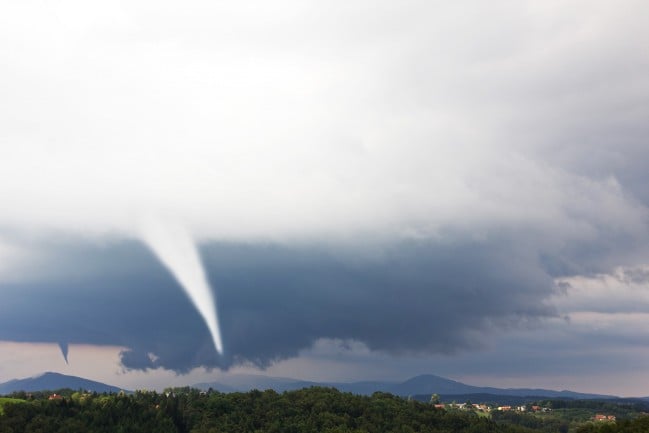 Tornadoes (from the Latin tornare, “to twist or turn”) are destructive rotary funnel clouds. Born from powerful thunderstorms, they can wipe out a neighborhood in mere seconds. Wind speeds can reach 300 mph, and the path of devastation can be one mile wide and fifty miles long. Tornadoes usually form at the trailing edge of a thunderstorm.
Tornadoes (from the Latin tornare, “to twist or turn”) are destructive rotary funnel clouds. Born from powerful thunderstorms, they can wipe out a neighborhood in mere seconds. Wind speeds can reach 300 mph, and the path of devastation can be one mile wide and fifty miles long. Tornadoes usually form at the trailing edge of a thunderstorm.
Sometimes you can tell when a tornado is approaching. Weather stations announce when a tornado is likely or imminent, giving you time to prepare. Other times they can form so quickly that there is no time to send out a warning. There are also times when the only reason you know a tornado is present is because of the swirling funnel of debris; the rest of the tornado is practically invisible.
On This Page:
Having a Plan in Place Before the Storm
Although they are mostly associated with the Midwest and “Tornado Alley”, no state is immune to tornadoes. Even sunny California experienced seven of them in 2014. Therefore, it only makes sense to take some precautions and have procedures in place in the event of a tornado.
Preparedness for a tornado begins even before a tornado watch goes into effect. For preparation you need to know:
- What to do – If you are at home, close your doors and windows. (The urban myth about opening your doors and windows to “equalize pressure” is just that, a myth.) If you can’t get them all closed, leave them. You and your family are more important. (Closing exterior doors and windows helps keep rain and small debris out. Closing interior doors helps compartmentalize your house and puts more barriers between you and the storm.)
- Where to go – Ideally, you want to get to a room without windows and as low as possible. Be aware of what’s overhead and try not to be under heavy furniture on the floor above. They can crash through a weakened floor. The perfect place to go is a storm shelter.
- Wherever you go, be sure you have padded items, such as mattresses and heavy blankets nearby. Flying debris can cause severe injury, and these items can shield you from harm.
- If you are on the road, don’t stay in your car. Get out and find a low depression on the ground, such as a ditch. Cover your head and lie as flat as possible. Stay there until the storm dies.
- If you are in town, don’t take shelter in buildings with wide span roofs. The design of these buildings puts the load of the ceiling on the outer walls, making them prone to collapse. Look for a building with a smaller footprint. Pay attention to places you frequent so that you know ahead of time where the safest places are.
- How to meet up afterwards – After a disaster, it’s natural to want to know that everybody’s all right. Part of your procedures should be to designate a meeting place and be sure everyone knows how to get there. It’s a good idea to have one or two alternative meeting places in case the first choice isn’t safe or can’t be reached. Don’t rely on cell phones and other technology to establish contact. Any networks or towers that are still functioning are needed by emergency responders.
Discuss your plan with your neighbors and share tips. You may be helping each other out afterwards.
Disaster Kits
As well as the above, a disaster kit is critical. You should have one in your home, in your car, and, when practical, on your person. You will not always be home, you will not always be in your car, but you will always be you.
Home Tornado Kit
Your tornado kit at home should include the following:
- First aid supplies
- Food and water (water should be 1 gallon per person per day for three days)
- Diapers and baby formula if you have an infant
- Pet food and water if you have pets
- Important papers
- Prescription medicines
- Over the counter medicines such as NSAIDs and wound cleaners (hydrogen peroxide, bactine)
- Matches and candles (do not use if gas leaks are present)
- An emergency radio powered by solar, batteries, or the kind you shake
- Flashlights
- Battery operated cell phone charger
- Spare batteries for the radio, flashlights, and charger
- Non-perishable food items
- Manual can opener
- A tent or tarps for shelter
- Rain gear
- A generator with fuel
- Emergency blankets or sleeping bags
- Tools for digging out (saws, shovels, picks, etc.)
- Insulated poles for moving electrical wires (Never try to move a downed power line, though! This pole is for moving your household wires out of the way so you can get out.)
- Rope
- Signal flares
- Light sticks
- Air horns or whistles (useful for signaling to one another)
- Good, sturdy work shoes or boots and a heavy “lumberjack” style jacket to protect yourself from sharp debris
- Cash and credit cards
- Spare keys
Larger items like tools can be kept in a footlocker in your shelter. Not only does this mean you won’t have to carry them to your shelter, but it keeps them all in one place. The other items should be kept in easy-to-reach duffel bags or backpacks that weigh no more than 20 or 30 pounds so that any family member can carry them.
Keep your disaster kit in an easily accessible area, such as a closet. Make sure they can be grabbed quickly and that everybody knows where all of the kits are.
Car Disaster Kit
A car disaster kit is considerably smaller than a home kit. Keep your gas tank full and keep the following in your trunk or in a secured, bolt-on toolbox:
- Jumper cables
- Flashlights with spare batteries
- First aid kit
- Food items containing protein such as nuts or energy bars, canned fruit, and a manual can opener
- Water
- Radio
- Cat litter in case you need better traction
- Shovel (many camping stores sell small, collapsible shovels based on military models)
- Matches
- Ice scraper
- Cold weather clothes
- Emergency blankets or sleeping bags
- Pocket knife
- Flares
- Fully charged cell phone
- Flares or reflective triangles
Useful Items to Have Close
Obviously, you can’t carry as much on you as you have in your home or car kit. You can, however, keep a few useful items in your pockets, attached to your keychain, or in your purse or wallet:
- Small flashlight
- Pocket knife
- Cash
- Glow sticks
- Lighter or matches
Know the Signs of a Tornado
While the radio and TV will let you know if there’s a tornado watch or warning, sometimes you aren’t near one. You may be out for a walk or a jog, or outside taking care of the yard. You could be anyplace where you just don’t have a radio or TV on. By learning the signs of a tornado, you can take proactive steps to get to safety quickly. Watch for the following:
- A dark, sometimes greenish sky
- Large hail
- A large, dark cloud hanging low in the sky, especially if it looks like it’s rotating
- A loud roar not unlike a freight train
- Any approaching storm
- Small flashes from near ground level near a thunderstorm. (These are power lines snapping in the wind.)
- Persistent lowering at the cloud base, often with lightning.
- Dust or debris whirling around a cloud base. (Not all tornadoes have a visible funnel!)
If you see any of these danger signs, get to a radio or TV set quickly and get information and advisories. If you see the clouds rotating, get to shelter.
If you have children, educate them on what to look for. Be sure they know what the early signs are. Especially teach them how to find shelter if they are away from home, such as at school or a friend’s house.
- Conduct regular practice drills so that everyone in your family knows what to do and where to go as second nature. Having drills is important to your family’s survival, and if the children are repeatedly trained in what to do, they will be less prone to panic in the event of a tornado. The number of very young children who know to dial 911 during home emergencies is proof that early education is very effective.
- When conducting drills, if someone seems to have trouble it’s important not to get angry or upset. Make note of what they’re having trouble with, and then try to work with them one on one to find out why. A small child may not be as diligent about keeping their disaster kit easily accessible, or their kit may just be too heavy.
Tornado Alerts
Tornado alerts are most often your first indicator that you need to get to safety. They can be heard from many different sources. There are very few reasons not to be aware of an oncoming tornado.
The first thing is to know the difference between a tornado “watch” and a tornado “warning”.
- A tornado watch means that conditions are right for a tornado to form, but one hasn’t formed yet. When a watch is in effect, that’s a good time to double-check your plan and make sure everybody can get to safety. Keep your eyes and ears open in case it escalates to a warning.
- A tornado warning means that a tornado has been sighted or has shown up on radar. This is the time to get everyone to safety and wait for it to be clear.
There are many ways to be made aware of tornado alerts, whether a watch or a warning. Remember that none of these will work if you choose to ignore them:
- NOAA Radio – The National Oceanic and Atmospheric Administration (NOAA) broadcasts weather conditions throughout most of the United States via the National Weather Service. Weather radios are tuned to pick up your local frequency and are available wherever radios are sold.
- Television – TV stations are notorious for interrupting your favorite shows for all kinds of things. Some are important, some aren’t, but tornado alerts should receive your highest attention.
- Applications – Automated phone calls can alert you to potential tornadoes, and your computer can receive an automatic message. If you are connected, you are alerted.
- WEA – Wireless Emergency Alert (WEA) is a free service that sends text messages to your phone.
- EAS – The Emergency Alert System has proven reliable for years. If you’re watching TV or listening to the radio and the alert suddenly breaks in, listen to it. It may be just a regular monthly test, but it could also be a warning that you need to get to cover immediately.
- Sirens – Air raid sirens, or “civil defense sirens”, have been used to alert the general public to danger since World War 2. Loud and almost impossible to miss, sirens may not give you any specific information, but they can warn you to get to a radio or TV to hear what’s going on.
What to Do If…
There are a number of situations you may find yourself in when a tornado strikes. Here are some of the most common and what procedures you should follow:
- House with a basement – Stay away from windows. Flying glass can cause serious injury. Get into the basement and take shelter under something sturdy, such as a workbench. Cover yourself with a mattress or heavy blanket to protect yourself from flying debris. If you have a helmet of some sort, put it on to further protect your head even if it’s just a bicycle helmet; it’s better than nothing. Avoid any spot in the basement where heavy furniture is overhead, as it can fall through a weakened floor.
- House without a basement; a dorm or apartment – Stay away from windows. Get to the lowest floor, a small central room (closet, bathroom, etc.), under a stairwell, or into a windowless interior hallway. Crouch as low as possible, covering your head. If you have a central bathroom on the lowest floor, crouch in the bathtub, covering yourself with a thick blanket or a mattress to protect from falling debris.
- Office, hospital, or skyscraper – Get to the lowest floor you can, staying away from windows. Interior stairwells are a good choice and, if they’re not crowded, can help you quickly get to a lower floor. Avoid elevators. If the power goes out you could be trapped inside.
- Mobile home – No mobile home is safe. Get out and head to the nearest permanent building or shelter. (This should be part of your disaster plan.) Even if your mobile home is tied down, it won’t withstand the force of a tornado determined to take it out.
- School – Do everything you learned during the drills. Get to an interior hallway or a room with no windows. Avoid large rooms such as the gym or auditorium. Move in an orderly manner. Crouch low and protect your head.
- Store or shopping mall – Be mindful of other people and don’t try to crowd anywhere. Move in an orderly fashion towards interior bathrooms, store-rooms, or other interior spaces with no windows.
- Church or theater – Move in an orderly fashion to interior bathrooms or hallways. Stay away from windows. If moving to an interior room is not possible, take shelter under the seats or pews. Protect your head.
- Motor vehicle – During a tornado, remaining inside a vehicle is dangerous, but you may have no choice. If you find yourself suddenly caught in high winds with debris flying around, get safely off the road. Leave your seatbelt on but crouch as low as you can, getting below the level of the windows. Cover yourself with a coat or blanket (or even a seat cushion) and protect your head. If you’re near an area where you can quickly get below the level of the roadway, leave your car and get into the lower area, lying as flat as you can and covering your head. If you are driving and see the tornado but haven’t been caught by it, drive away from it at right angles. This should take you out of its path.
- Outdoors – Get into a sturdy building if at all possible, getting into an interior room. If you have no building, lay as flat against the ground as you can, seeking a ditch or depression if possible. Protect your head. Stay away from cars, trees, or anything else that can get blown on top of you. Tornadoes move at an average speed of 30 mph, but can range from standing still to 70 mph, so don’t count on out-running it!
- On the water – If you are on a lake and you become aware of an impending tornado, get off the water as fast as possible and seek shelter in a sturdy building. Tornadoes can actually pick up strength when crossing bodies of water.
Tornado Safety Procedures and Apartments
If you live in a high-rise apartment, you want to get to the lowest floor possible. Take shelter any place that has no windows, such as an interior hallway or bathroom, or a closet. If there are interior stairwells, those can offer a good deal of protection. Crouch low and protect your head. Use a helmet if you can, even a bicycle helmet.
Check with your leasing manager or superintendent about where any storm shelters may be on the property.
After the Tornado
After the tornado has passed, you will probably want to come out and see who needs help and the general condition of your neighborhood. The rule here is to think before you act. Don’t just burst out of your shelter and start looking around. These tips will help you stay safe after the big danger has passed:
- Stay put until the storm has passed. You may be worried about how your house fared, but it can wait. Tornadoes can suddenly change direction, and head right back at you. Stay calm and remain in your shelter until you hear the “all-clear” signal.
- Be aware of the weather. Just because the tornado has passed doesn’t mean the weather is now fine. Floods, hail, and lightning can come in on the heels of a tornado. Never try to wade in the water during a flood, even if the current looks calm on the surface. It can be quite turbulent just beneath the surface. Debris can suddenly take your legs out from under you and the water is most likely carrying sewage and disease.
- Use your flashlights instead of candles. You may not notice a gas leak at first. Use flashlights until you know for sure you’re safe. Then you can use the candles to conserve battery power.
- See if anyone is injured. Begin first aid immediately. Get help if at all possible.
- Get someplace safe. Your home or shelter may no longer be safe. For example, even if your home survived, if it’s near a rising river get out. Head to one of your alternative safe places or to a FEMA or Red Cross camp, bringing your kits with you.
- Stay away from hazards. Downed power lines and anything they’re in contact with should be avoided. If one end is in the water, stay away from that water entirely or risk electrocution. Also stay away from debris, fallen trees, water courses (they could surge), anything that could collapse, and other dangers.
Tornadoes are among the most frightening disasters a person could go through. By following these rules and tips and taking precautions, you can dramatically increase your chances for survival.
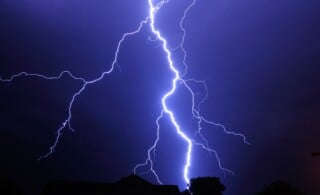 Guide to Severe Thunderstorms
Guide to Severe Thunderstorms 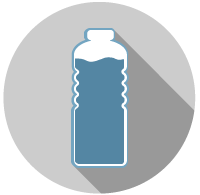 10 Essential Tornado Supplies For Your Survival Kit
10 Essential Tornado Supplies For Your Survival Kit 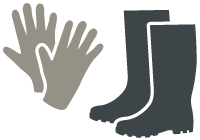 5 Post-Tornado Safety Tips That Could Save Your Life
5 Post-Tornado Safety Tips That Could Save Your Life 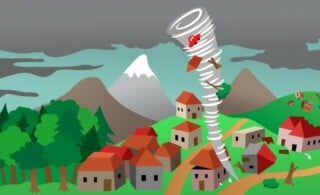 Fun & Interesting Facts About Tornadoes For Kids
Fun & Interesting Facts About Tornadoes For Kids 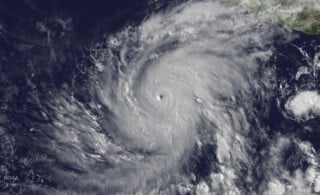 Hurricane Safety Tips
Hurricane Safety Tips 

Are You Familiar With This Topic? Share Your Experience.